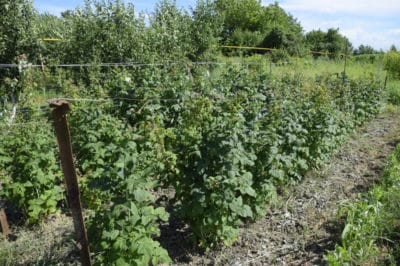Other Benefits of Trellising
A more bountiful raspberry crop is a smart reason to trellis raspberry canes, but not the only reason. Other benefits that make growing raspberries on a trellis more pleasurable are:
- Harvesting is easier.
- Plants are more disease resistant.
- Quality of fruit improves.
- Sunlight exposure is greater.
- Air circulation is better.
- Pruning is easier.
Trellis Types
From simple to elaborate, trellises can be constructed to meet the needs and budgets of all growers. With a little know-how and a creative mind, a raspberry trellis can be constructed and provide years of useful service. Trellises can also be purchased if do-it-yourself construction is not possible. Determine your needs and decide which type of trellis is best.
I-Trellis
The I-trellis is easy to build and less expensive than other trellises used for raspberries. The first step in constructing this trellis is burying two or more 6-8 feet posts 2 feet into the ground. Space posts 25-30 inches apart. Posts can be metal fence posts, cedar posts, or pressure-treated posts (diameter of 4-6 inches).
Wire is attached to the outsides of the posts spreading from one post to another the length of the raspberry hedgerow or bed. A 12 gauge wire should be attached to the posts about 4 feet up from the ground. This bears most of the weight of the canes. A 14 gauge wire should be attached to the posts about 18-24 inches from the soil’s surface.
Guide raspberry canes between the two wires as they grow upward. Crowding will occur with this type of trellis and will increase the chances of disease. It may be the most economical trellis to build, but the design is not the best for harvesting or superior fruit production.
V-Trellis
The V-trellis is the most common trellis used for raspberries. The main purpose of the V-trellis is to separate the floricanes (second-year growth) from the primocanes (first-year growth). Many growers construct simple V-trellis systems; however, trellis systems like the AV (adjustable V) Trellis System can be purchased.
The typical V-trellis is constructed of two wood or metal posts set 2 feet into the ground about 18 inches apart. The two posts should set 20 to 30 degrees from vertical forming a V and extend at least 5 feet from the ground. This is repeated at the other end of the row or about every 25 feet.
Strong wire should be stretched horizontally from one post to the other. Attach the wire to the posts near the top and about 18 inches from the ground.
California V-Trellis
From the Norwegian Gjerde trellis system, a modification called the California V-trellis was developed. Basically, 1-inch by 1-inch posts are connected at ground level to a center post with rubber ties (or other flexible material). The almost vertical posts will extend outward forming a V as the vines spread upward.
Growers sometimes tie the older floricanes that produce fruit first in the season to the outside of the wires. The primocanes grow in the middle of the wires, producing fruit later in the season. This trellis system allows better air flow; thus, discouraging disease. Less disease means quantity and quality of fruit are better.
Wood T-Trellis
A wood T-trellis consists of sturdy posts with one or two cross arms. Heavy gauge wire is horizontally stretched from each end of the cross arms to the cross arms at the opposite end of the row.
The main posts (pressure treated or cedar) should extend 6 feet above the ground. Cross arms are made of 2-inch by 4-inch pressure treated lumber. Cross arms should be 36-42 inches long and attached to the center posts 3 inches from the top. A double T-trellis cross arm is 2 feet long and affixed about 18 inches from the ground.
Shift Trellis
Shift trellises are designed to shift from a vertical position to a horizontal position, allowing the raspberry fruit to primarily grow on one side. Growing raspberries on this trellis may be more labor intensive while growing, but the harvest is easier.
The main posts are made of wood and allow the supporting wires to pivot in an arc from one side of the row to the other side. The grower moves the supporting wires into a horizontal position early in the growing season: later it is in a vertical position.
